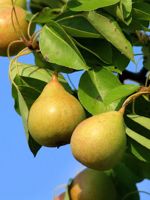Mon-Fri 9am - 5pm Mountain time
Black Locust vs Loving Pear
Robinia pseudoacacia
Pyrus Loving
COMING SOON
(new stock expected: later this season)
Black Locust is an attractive tree. Its distinctive leaves are made of about a dozen bright green leaflets. It also notable for its fragrant white flowers, which smell of citrus.
Black Locust can grow in many situations, but prefers dry areas with lots of sun. It is robust and is an excellent choice for establishing shade in dry, open areas.
Important note: Much of the Black Locust is toxic to humans and livestock, including seeds, bark, and leaves.
Loving Pear is a Russian pear variety with a mild sweet flavor and a hint of sour. It is known for being cold hardy and disease resistant. They are green in colour but will transition to have a slightly golden red blush when ripe. With a minimal neck, they have a more rounded appearance.
They ripen in early September. It is recommended that they are harvested as the seeds begin to brown. They can finish ripening after picking. They keep well in cold storage and are suited for fresh eating, juicing, and dehydrating.
The Loving Pear requires a second variety for cross pollination. Some compatible varieties include Krazulya, Golden Spice, and others.

